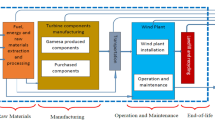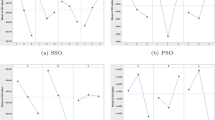Abstract
This paper proposes a new wind farm layout optimization methodology based on a genetic algorithm by implementing a simulation model considering wake effect. This method consists of (1) batch optimization to efficiently obtain a rough wind farm layout for the maximum energy production in a large scale, and (2) post-optimization to obtain a refined layout to further improve the energy production in a small scale. The proposed two-step optimization enables to efficiently optimize wind farm layout and thus can be applicable to layout optimization of large-scale wind farms. A case study with the actual Daegwallyeong wind farm shows that wake loss is improved by 2.3% point after the proposed layout optimization which means about 2.5% more energy production compared with the existing layout.










Similar content being viewed by others
References
L. Chen, E. MacDonald, A system-level cost-of-energy wind farm layout optimization with landowner modeling. Energy Convers. Manag. 77, 484–494 (2014)
B.L. Du Pont, J. Cagan, An extended pattern search approach to wind farm layout optimization. J. Mech. Des. 134(8), 081002 (2012)
R. Shakoor, M.Y. Hassan, A. Raheem, Y.K. Wu, Wake effect modeling: a review of wind farm layout optimization using Jensen׳ s model. Renew. Sustain. Energy Rev. 58, 1048–1059 (2016)
J. Shin, I. Lee, Reliability-based vehicle safety assessment and design optimization of roadway radius and speed limit in windy environments. J. Mech. Des. 136(8), 081006 (2014)
J.W. Ha, S. Kim, A study on the wind power generation and its economic feasibility at Daekwanryung. J. Energy Eng. 14(2), 123–132 (2005)
J.K. Woo, H.G. Kim, B.M. Kim, I.S. Paek, N.S. Yoo, Prediction of annual energy production of Gangwon Wind farm using AWS wind data. J. Korean Sol. Energy Soc. 31(2), 72–81 (2011)
Y. Nam, N. Yoo, J. Lee, Site calibration for the wind turbine performance evaluation. KSME Int. J. 18(12), 2250–2257 (2004)
B.H. Cho, J.W. Lee, Establishment of remote monitoring system for wind turbine test sites based on hierarchical architecture. J. Korean Soc. Precis. Eng. 26(9), 81–87 (2009)
M.S. Lee, S.H. Lee, N.K. Hur, A numerical study on the effect of mountainous terrain and turbine arrangement on the performance of wind power generation. Trans. Korean Soc. Mech. Eng. B 34(10), 901–906 (2010)
H.G. Kim, Comparative analysis of commercial softwares for wind climate data analysis. J. Korean Soc. New Renew. Energy 6(2), 5–11 (2010)
K. Lee, I. Lee, Optimization of a heliostat field site in central receiver systems based on analysis of site slope effect. Sol. Energy 193, 175–183 (2019)
S. Kim, I. Lee, B.J. Lee, Development of performance analysis model for central receiver system and its application to pattern-free heliostat layout optimization. Sol. Energy 153, 499–507 (2017)
G.P.C.D.B. Mosetti, C. Poloni, B. Diviacco, Optimization of wind turbine positioning in large windfarms by means of a genetic algorithm. J. Wind Eng. Ind. Aerodyn. 51(1), 105–116 (1994)
S.A. Grady, M.Y. Hussaini, M.M. Abdullah, Placement of wind turbines using genetic algorithms. Renew. Energy 30(2), 259–270 (2005)
J.C. Mora, J.M.C. Barón, J.M.R. Santos, M.B. Payán, An evolutive algorithm for wind farm optimal design. Neurocomputing 70(16–18), 2651–2658 (2007)
H.S. Huang, Distributed genetic algorithm for optimization of wind farm annual profits. In 2007 International Conference on Intelligent Systems Applications to Power Systems (pp. 1–6). IEEE (2007)
S. Şişbot, Ö. Turgut, M. Tunç, Ü. Çamdalı, Optimal positioning of wind turbines on Gökçeada using multi-objective genetic algorithm. Wind Energy Int. J. Prog. Appl. Wind Power Convers. Technol. 13(4), 297–306 (2010)
H.S. Huang, Efficient hybrid distributed genetic algorithms for wind turbine positioning in large wind farms. In 2009 IEEE International Symposium on Industrial Electronics (pp. 2196–2201). IEEE (2009)
H.H. Yildirim, S. Sakarya, Investment evaluation of wind turbine relocation. Int. J. Optim. Control: Theor. Appl. (IJOCTA) 9(3), 6–14 (2019)
C.J. Rydh, M. Jonsson, P. Lindahl, Replacement of old wind turbines assessed from energy, environmental and economic perspectives. Other Inf. 38, 1–26 (2004)
N.O. Jensen, A note on wind generator interaction. Technical Report Risø-M-2411, Risø National Laboratory (1984)
E.H. Cheang, C.J. Moon, M.S. Jeong, K.P. Jo, G.Y. Park, The study for calculating the geometric average height of Deacon equation suitable to the domestic wind correction methodology. J. Korean Sol. Energy Soc. 30(4), 9–14 (2010)
E.L. Deacon, P.A. Sheppard, E.K. Webb, Wind profiles over the sea and the drag at the sea surface. Aust. J. Phys. 9(4), 511–541 (1956)
Korea Meteorological Agency. “Long-term weather observation”. https://data.kma.go.kr/data/grnd/selectAsosRltmList.do?pgmNo=36. Accessed 25 Sep 2019
Korea Meteorological Agency. “Observation point data–Sensor/observation elements”. https://data.kma.go.kr/tmeta/comp/selectCompSenList.do. Accessed 25 Sep 2019
Acknowledgements
This research was supported by Energy Cloud R&D Program through the National Research Foundation of Korea (NRF) funded by the Ministry of Science, ICT (No. 2016006843).
Author information
Authors and Affiliations
Corresponding author
Ethics declarations
Conflict of interest
The authors declare that they have no conflict of interest.
Rights and permissions
About this article
Cite this article
Park, J.W., An, B.S., Lee, Y.S. et al. Wind farm layout optimization using genetic algorithm and its application to Daegwallyeong wind farm. JMST Adv. 1, 249–257 (2019). https://doi.org/10.1007/s42791-019-00026-z
Received:
Revised:
Accepted:
Published:
Issue Date:
DOI: https://doi.org/10.1007/s42791-019-00026-z




